SELECTING THE R/C AIRPLANE
So you want the ultimate experience of building and flying your own R/C plane for the first time? This article is strictly meant for the first time flyer. It is very important to select the proper model that is going to be easy to build and fly. There are many trainers available that offer real aircraft performance. My personal selection for the best trainer is the NexSTAR by Hobbico. Fairly large with a 68 3/4" wingspan, using a .46 to .50 two stroke engine.
Your Hobbico NexSTAR should not be considered a toy, but rather a sophisticated, working model that functions very much like a full size airplane. Because of it's performance capabilities, the NexSTAR, if not assembled and operated properly could possibly cause injury to yourself or spectators and damage to property.
show any signs of wear. If you are not an experienced pilot or have not flown this type of model before you should get the assistance of an experienced pilot from your R/C club for your first flights.
| Before
starting to build your plane take an inventory of all parts in the
kit to make sure it is complete. |
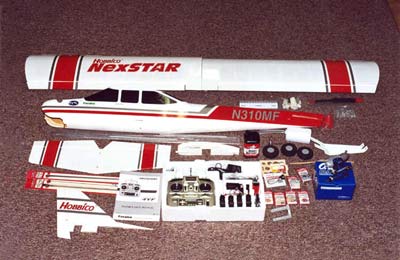 |
| Examine the kit |
The Hobbico system uses a three line fuel system to simplify fueling and de-fueling.
The NexSTAR incorporates three systems that are very important. The centercore wing rib is a nylon part that is preinstalled into one of the wing halves. It aligns the two wing halves; it is a mount for the aileron servo; the wing dowel holds the wing in place and aligns the bolt to the wing mounting system. This makes joining the wing halves to the fuselage very easy.
There are extensions installed at the leading edge near the wing tips. These Spincontrol Airfoil Extensions were developed by NASA to help light planes prevent stalls and spins during landing. They slow down the airplane, increase stall resistance and prevent it from spinning. After you become proficient as a pilot you can remove them for better aerobatic performance.
 Spincontrol airfoil extensions prevent stalls and spins |
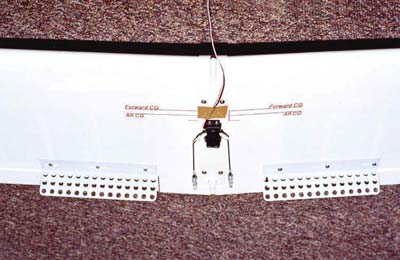 C/G markings, aileron servo, speedbrake flaps |
- Do not fly near other R/C flying fields
- near people on the ground, or objects in the air
- near homes, schools, hospitals, or any place where there are a lot of people
- near high tension lines, high structures, or communication facilities
When turning on the power switch, after setting the transmitter throttle lever to maximum slow: turn on the transmitter power switch. Then turn on the receiver power switch. After stopping the engine, turn off the receiver power switch, and then turn off the transmitter power switch. If the power switch is turned off in the opposite order, the engine may go to full throttle unexpectedly and cause an injury.
 Futaba R/C set |
Before making any adjustments, set all servo reverser switches on the front of the transmitter to the lower (nor) position. Turn on the transmitter and receiver power switches and make the following adjustments:
- Check the direction of operation of each servo. If a
servo operates in the wrong direction, switch the servo reverser.
- Check the aileron, elevator, and rudder neutral adjustment and left-right
(up-down) throw.
- Check the engine throttle (speed adjustment) linkage. Change the servo
horn installation position and hole position so that the throttle is opened
fully when the throttle stick is set to high (forward) and closed fully
when the throttle stick and trim are set for maximum slow ( backward and
lower position respectively).
- After all the linkages have been connected, recheck the operating direction,
throw, etc.
- Fly the plane and trim each servo.
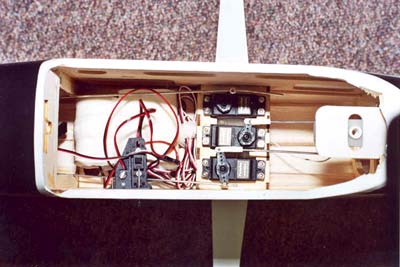 Receiver, battery, servos mounted in fuselage |
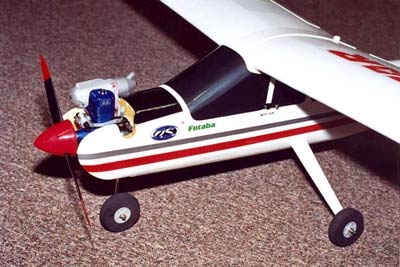 Motor installed |
 Model complete |
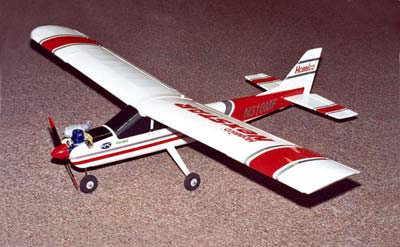 NexSTAR complete |
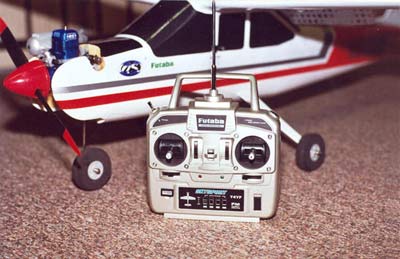 Ready to fly |